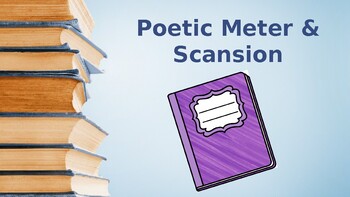
Poetry scansion tool license#
However, there is the license of putting a short syllable in this long element ( brevis in longo).Īn example of a line fitting the above schema is the first (and any other) line of Catullus 1: The last element of any meter is always marked as long in schemas. – marks a long syllable, ⏑ marks a short syllable and x marks a syllaba anceps meaning that it can be either long or short. But for one simple and popular meter, the Phalaecian Hendecasyllable, the schema is shown for illustration purposes: x x – ⏑ ⏑ – ⏑ – ⏑ – – There are various Latin meters (the Hypotactic corpus counts 273 meters, of which only 40 occur in more than 50 lines and only 13 occur in more than 500 lines) and this is not the place for a detailed summary of them. For example, “eorum” while usually having three syllables (e-o-rum) can be read as eo-rum. However, sometimes the two syllables are blended into one which is then long by nature of containing a diphthong. If inside of a word, one syllable ends with a vowel end next begins with a vowel, the first vowel is usually short (in Latin: vocalis ante vocalem corripitur). For example, “pressa est“ is read as “pressast”. “est” or “estis”, the first syllable of the form of “esse” is elided instead of the last syllable of the first word. If the above situation occurs, but the second word is a certain form of the auxiliary “esse” (“to be”), e.g. If the elision is not actually carried out, this is called a hiat. For example, in “quare habe” the second syllable of “quare” is elided resulting in the reading “quar(h)abe”. If one word ends with a vowel or an “m” (which is only nasalized) and the succeeding word begins with a vowel or an “h” (which is only an aspiration mark), the last syllable of the first word is elided.

For example, the second syllable of “volucris” (“bird”) can be considered long or short. If a syllable can be considered long by position but the causing consonant cluster consists only of a muta (b, d, g, p, t, k) followed by a liquida (l, r), it may indeed be considered long by position, but more often the lengthening does not occur.

However, as is often the case with language, a number of phenomena can occur that change the way the text is read impacting also the scanning of the line: In this case, the syllable is considered to be long “by position.”Īll other syllables are considered short. The syllable’s vowel is followed by two or more consonants (that may well be part of the next syllable or even the next word).In this case, the syllable is said to be long “by nature.” The syllable contains a long vowel or a diphthong.There are two common ways a syllable can be counted as long: Latin Metrics Metric PrinciplesĪs mentioned above, scanning a line means determining its syllables’ quantities. In addition to building a library to do this, a web interface should present the result in an easily digestible way, detailing also how the system arrived at its result, in order to help learners of Latin better understand the process. The attempt of this work, was to conceive of a system to automatically determine the quantities of a line’s syllables (a process called scanning) without overly focusing on one specific meter. For this reason, when automatic processing of Latin metrics is attempted, other meters are often overlooked in favor of the hexameter.

The hexameter is by far the most frequent one and is used primarily in the epos such as Virgil’s Aeneid and in didactic poetry such as Lucretius’s On the Nature of Things. There are about a dozen different meters that are frequently used in Latin verse and some more that occur less frequently. In contrast, Ancient Greek and Latin metrics was governed by a quantitative principle meaning that long syllables are considered marked and short syllables are considered unmarked. Most poetry in the Germanic languages is bound by accentuating (or qualitative) metrics, which means that accented syllables (as the determined by either loudness or pitch) are considered marked and non-accented syllables are considered unmarked. constraints that concern the rhythmic structure of the text in question: Each line of verse has to take a certain sequence of marked and unmarked syllables. This piece of work, however, focuses on metric constraints, i. These constraints can take various forms: For example, they can concern rhyme patterns or the way a text is laid out on paper. speech bound by constraints on the form instead of the content. One defining aspect of most poetry in opposition to prose is that poetry is “bound speech”, i.e. We provide a tool for measuring Latin verse, as well as a web application highlighting results and providing helpful annotation of phenomena that lead to this classification. Simon Will, Victor Zimmermann & Christoph Schaller


 0 kommentar(er)
0 kommentar(er)
